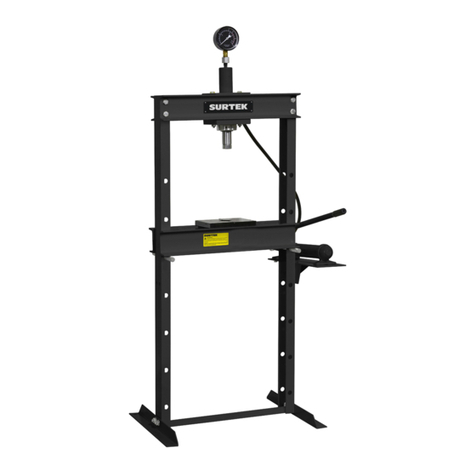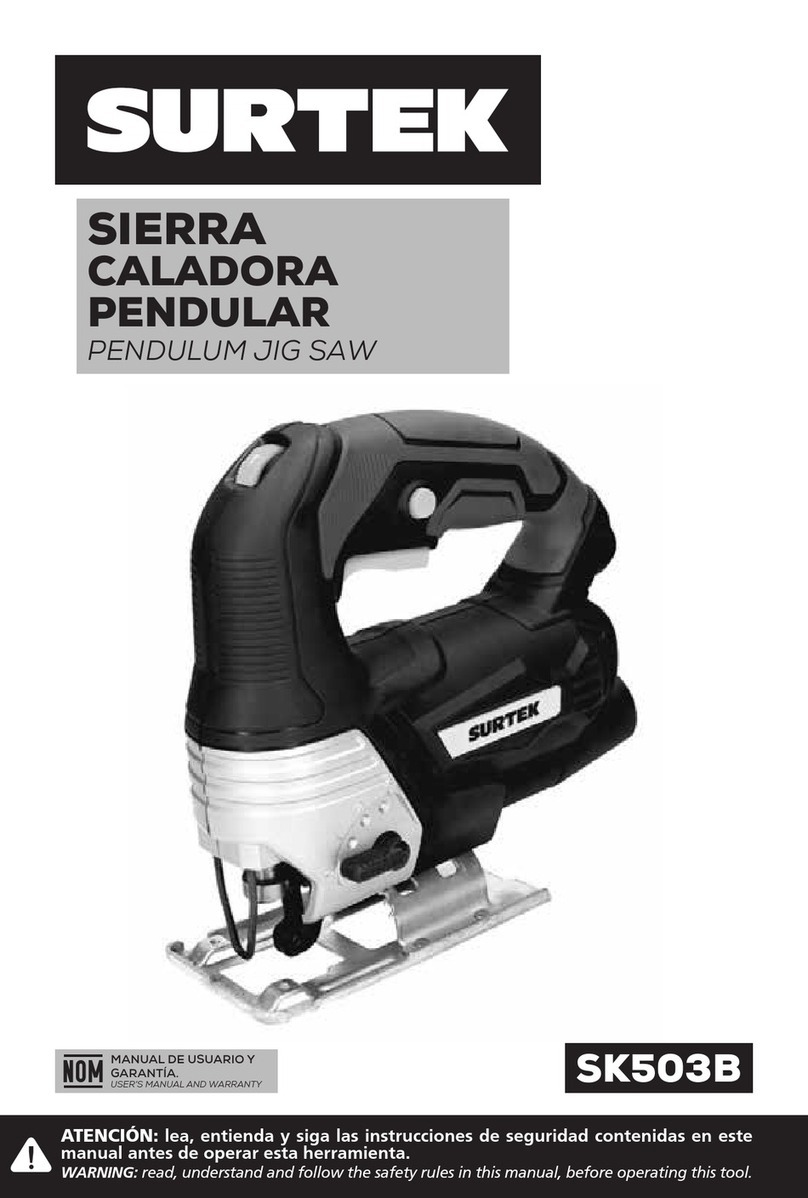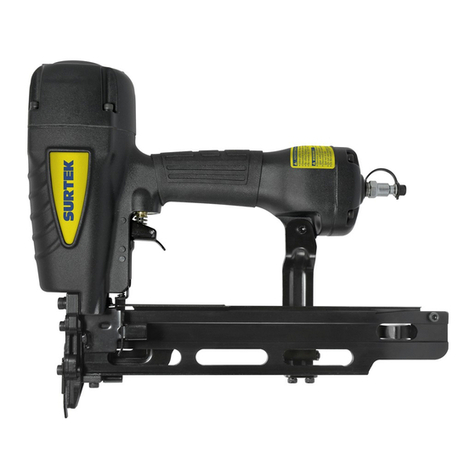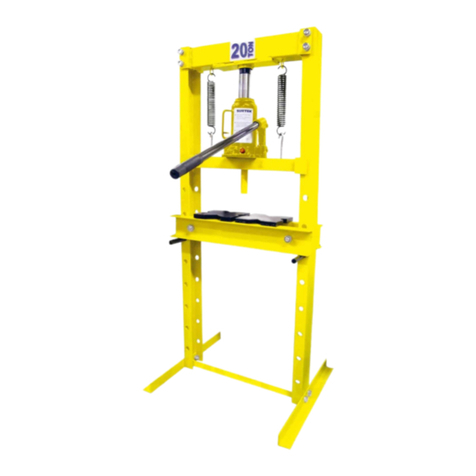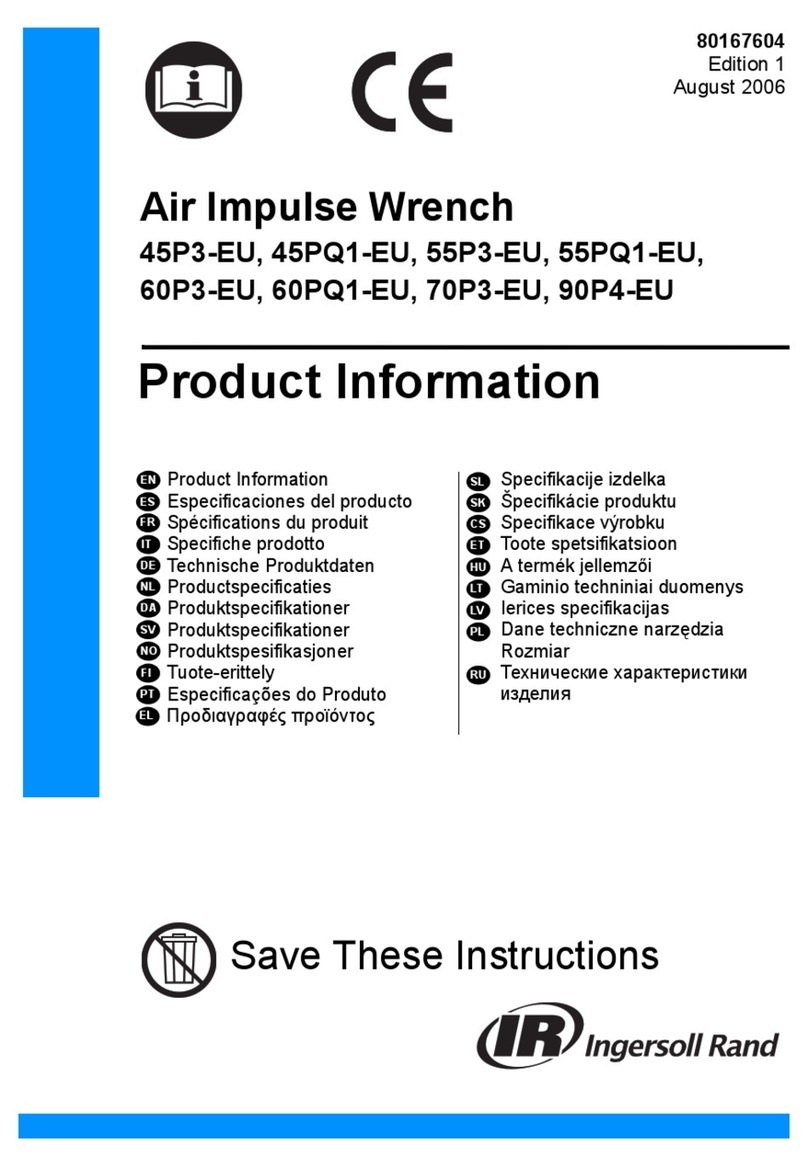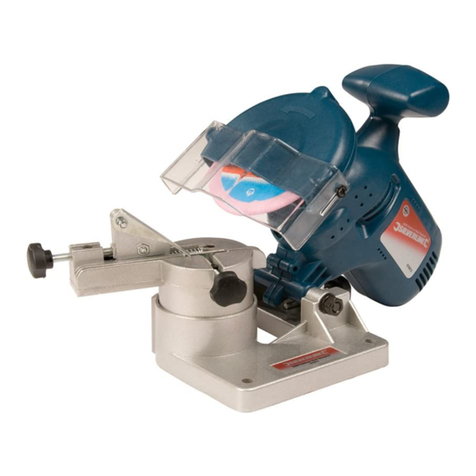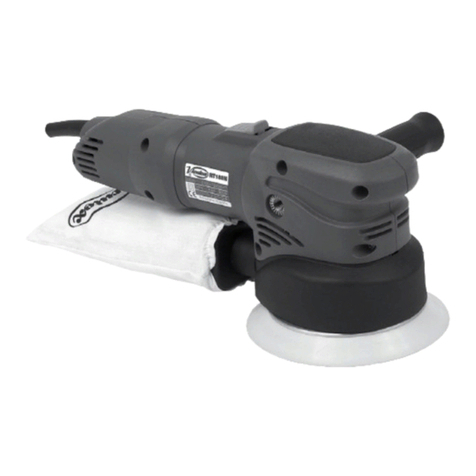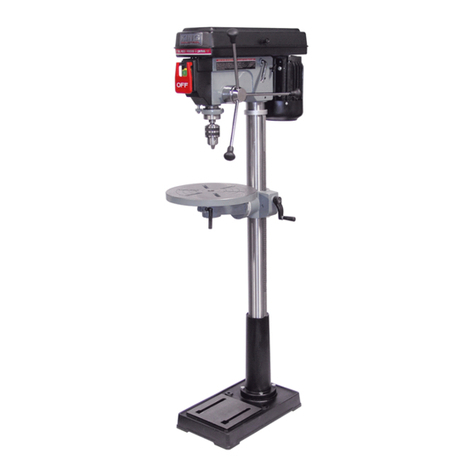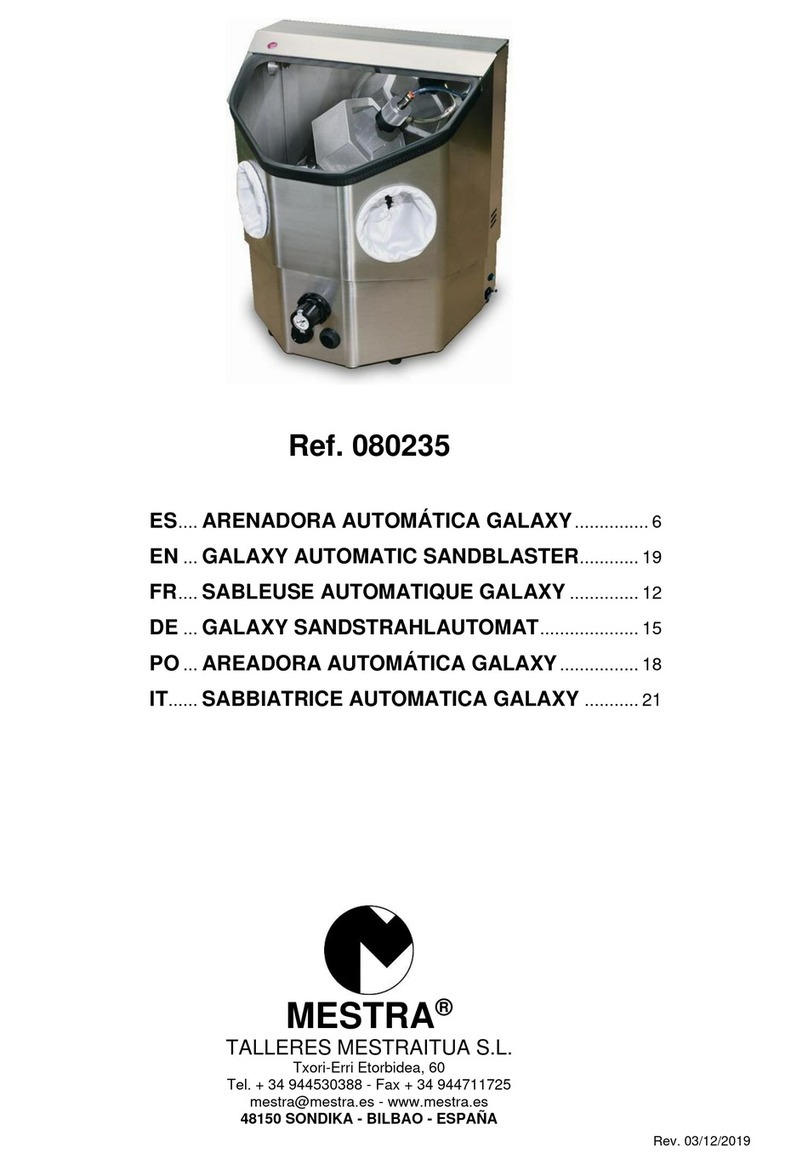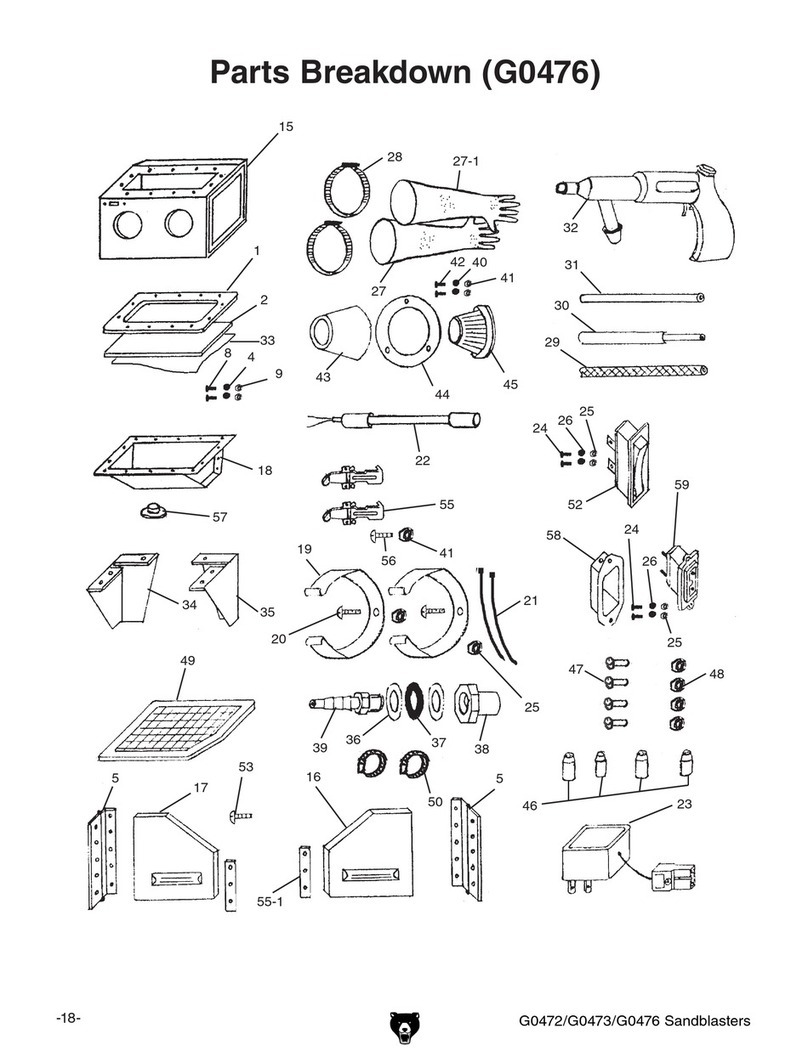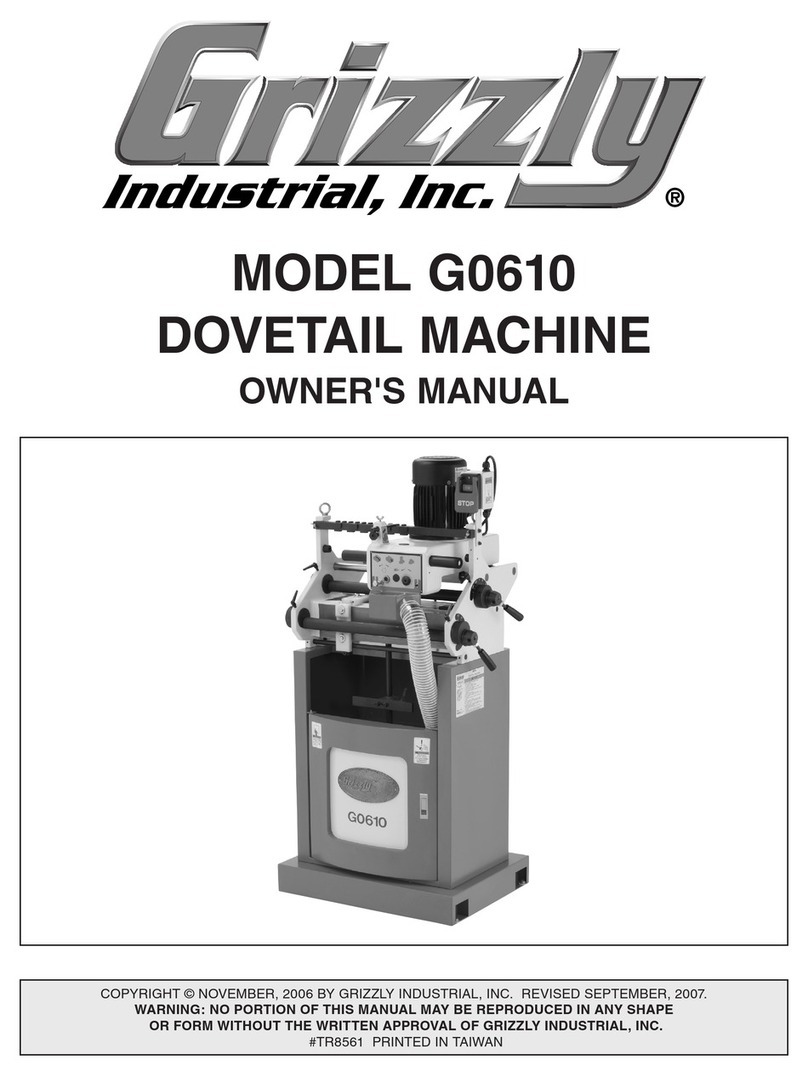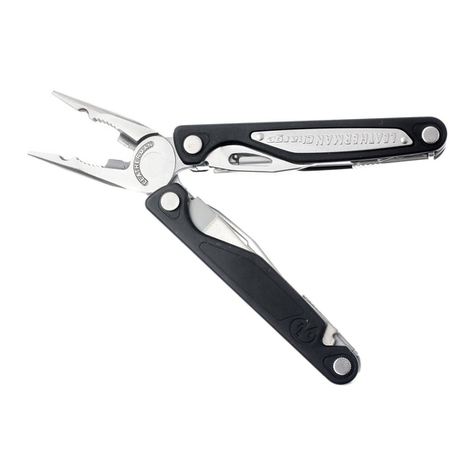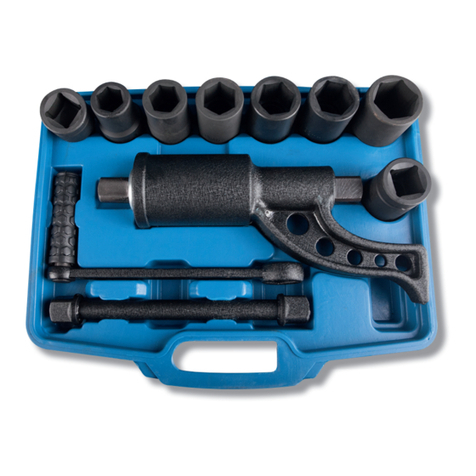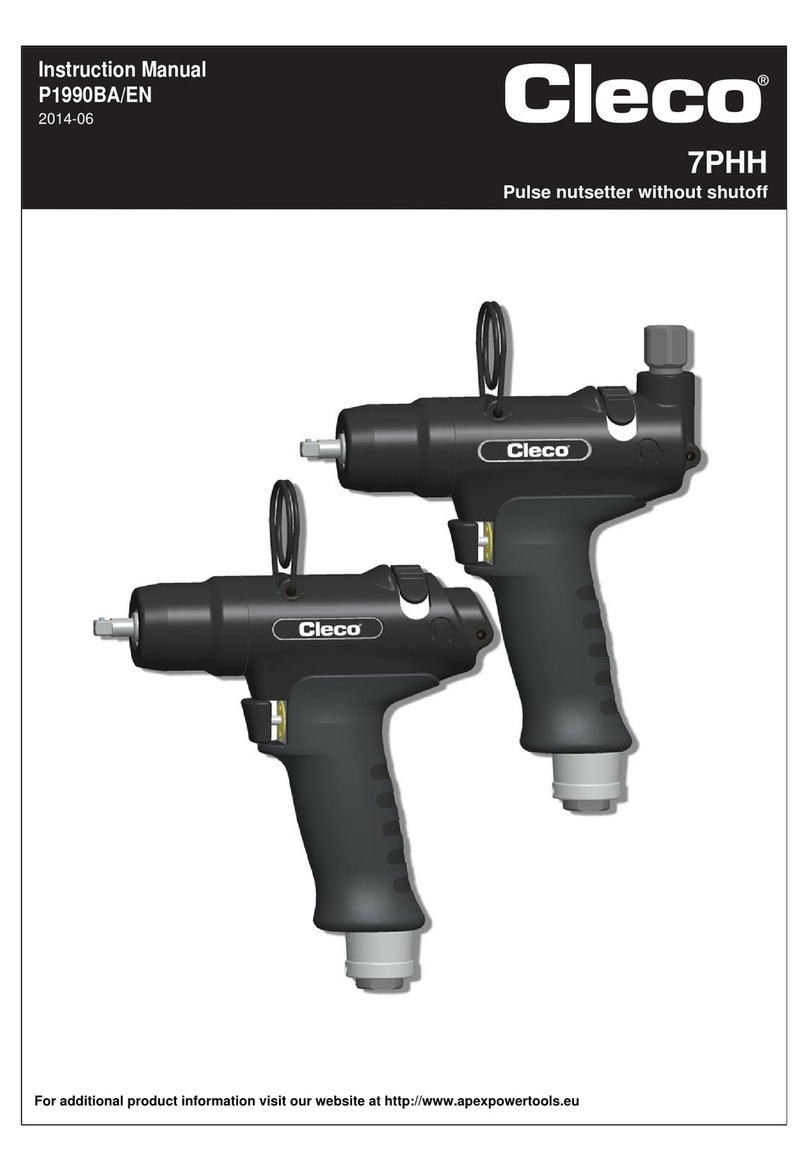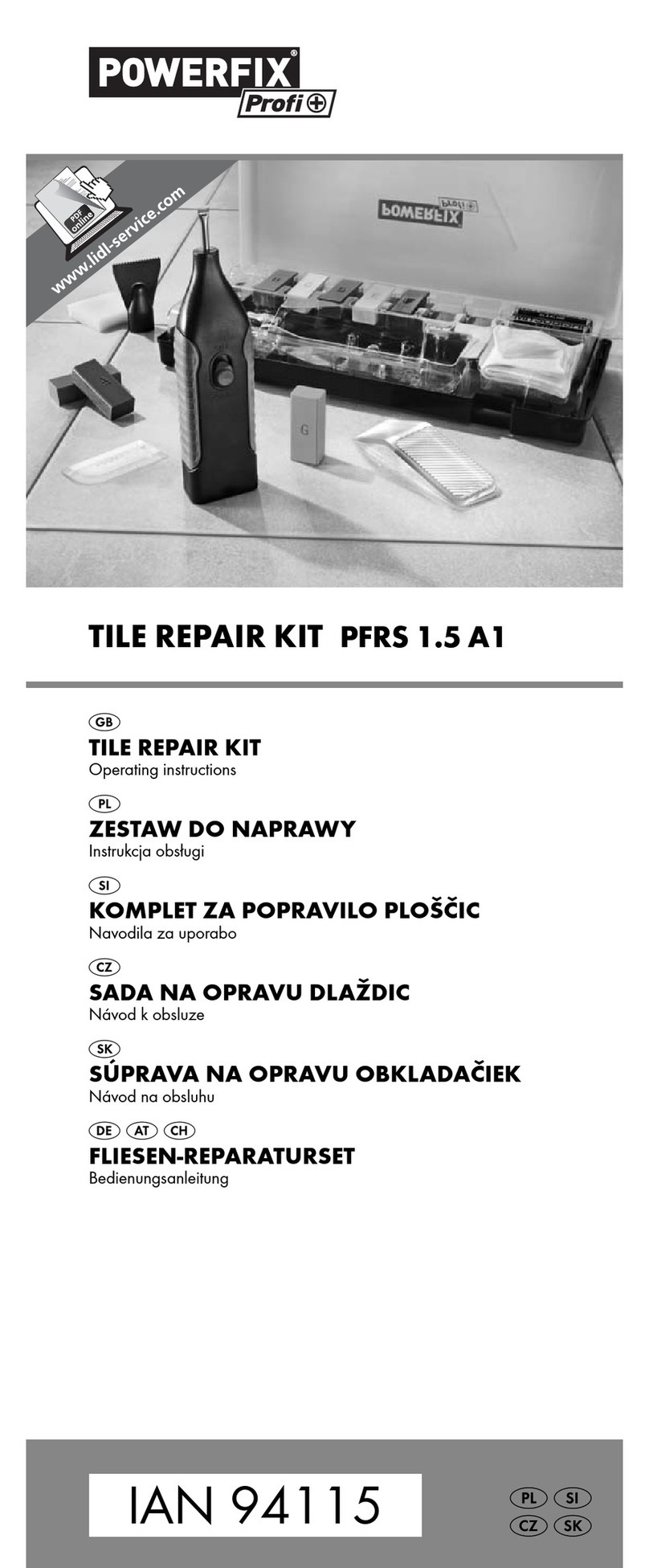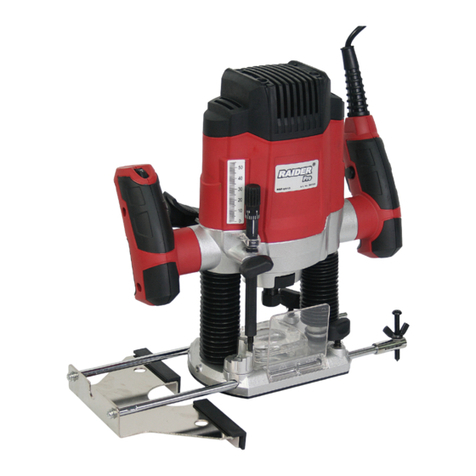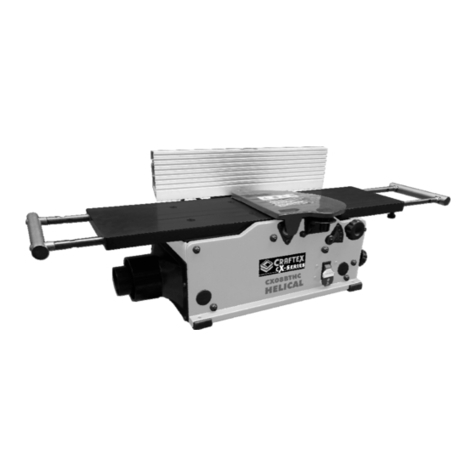Surtek MT514A User manual

ATENCIÓN: lea, entienda y siga las instrucciones de seguridad contenidas en este
manual antes de operar esta herramienta.
WARNING: read, understand and follow the safety rules in this manual, before operating this tool.
MT514A
MOTO TOOL
MOTO TOOL
MANUAL DE USUARIO Y
GARANTÍA.
USER’S MANUAL AND WARRANTY

2
ENGLISHESPAÑOL
General safety rules
Electric safety
Personal safety
Tool use and care
Specific safety rules for
moto-tools
Features
Technical data
Operation instructions
Maintenance
Warranty policy
Normas generales de seguridad
Seguridad eléctrica
Seguridad personal
Utilización y cuidados de las
herramientas eléctricas
Advertencias de seguridad para
moto-tools
Características
Especificaciones técnicas
Instrucciones de operación
Mantenimiento
Garantía
9
9
9
10
10
11
11
12
13
16
3
3
3
4
5
6
6
7
8
16
CONTENIDO CONTENT
SÍMBOLOS SYMBOLS
PELIGRO, ADVERTENCIA, PRECAUCIÓN:
Indica un riesgo personal o la posibilidad
de un daño.
Herramientas tipo II: Doble aislamiento,
protege las herramientas eléctricas.
Lea el manual de usuario: Lea las instruc-
ciones contenidas en este manual.
DANGER, CAUTION, WARNING: Indicates risk of
personal injury and/or the possibility of damage.
Type II power tools: Indicates double insulation.
Read the user manual: Read all the instructions in
this manual.

3
ESPAÑOL•Manual de usuario
NORMAS GENERALES DE SEGURIDAD
Este MOTO-TOOL tiene características que ha-
rán su trabajo más rápido y fácil. Seguridad, co-
modidad y confiabilidad fueron previstos como
prioridad para el diseño del mismo, haciendo
más fácil su operación.
ADVERTENCIA: Lea todas las advertencias
de seguridad y todas las instrucciones. La omi-
sión de alguna de las advertencias e instruccio-
nes que se enlistan a continuación puede dar
como resultado un choque eléctrico, fuego y/o
un daños serios. CONSERVE TODAS LAS ADVER-
TENCIAS Y TODAS LAS INSTRUCCIONES.
NOTA: La expresión “herramienta” en las adver-
tencias se refiere a la herramienta eléctrica que
se conecta a la fuente de alimentación (con ca-
ble) o a la herramienta que se acciona a batería
(sin cable).
SEGURIDAD EN EL ÁREA DE TRABAJO
Mantenga el área de trabajo limpia y bien ilu-
minada. Las áreas desordenadas y oscuras pro-
vocan accidentes.
No maneje herramientas eléctricas en atmós-
feras explosivas, tales como en presencia de
líquidos inflamables, gases o polvo. Las herra-
mientas eléctricas crean chispas que pueden en-
cender el polvo o los humos.
Mantenga alejados a los niños y curiosos mien-
tras maneja una herramienta eléctrica. Las dis-
tracciones pueden causarle la pérdida del con-
trol.
SEGURIDAD ELÉCTRICA
La clavija de la herramienta eléctrica debe
coincidir con receptáculo. No modificar nunca
la clavija de ninguna manera. No usar ningún
adaptador de clavijas con herramientas eléctri-
cas puestas a tierra. Clavijas no modificadas y
bases coincidentes reducirán el riesgo de cho-
que eléctrico.
Evite el contacto del cuerpo con superficies
puestas a tierra como tuberías, radiadores, co-
cinas eléctricas y refrigeradores. Hay un riesgo
aumentado de choque eléctrico si su cuerpo está
puesto a tierra.
No exponga las herramientas eléctricas a la llu-
via o a condiciones de humedad. El agua que
entre en la herramienta aumentará el riesgo de
choque eléctrico.
No abuse del cable. No usar nunca el cable para
llevar, levantar o desenchufar la herramienta
eléctrica. Mantenga el cable lejos del calor, acei-
te, cantos vivos o piezas en movimiento. Los
cables dañados o enredados aumentan el riesgo
de choque eléctrico.
Cuando maneje una herramienta eléctrica en el
exterior, use una prolongación de cable adecua-
da para uso en el exterior. El uso de una prolon-
gación de cable adecuada para uso en el exte-
rior reduce el riesgo de choque eléctrico.
Si el uso de una herramienta en un lugar hú-
medo es inevitable, use una alimentación pro-
tegida por un dispositivo de corriente residual
(RCD). El uso de un RCD reduce el riesgo de cho-
que eléctrico.
EXTENSIONES DE CABLE
NOTA: El uso de cables dañados incrementa el
riesgo de descargas eléctricas o quemaduras.
Si es necesario un cable de extensión, debe ser
usado un cable con el tamaño adecuado de los
conductores. La tabla de la siguiente página,
muestra el tamaño correcto para usar depen-
diendo en la longitud del cable y el rango de
amperaje especificado en la etiqueta de valores
nominales del producto. Si está en duda, use el
rango próximo más grande.
Siempre use cables de extensión listados en UL,
CSA ó NOM. TAMAÑOS RECOMENDADOS DE
EXTENSIONES DE CABLE:
Cuando esté usando el producto afuera, use
una extensión para exteriores marcadas con lo
siguiente: “WA” o “W”. Estas extensiones están
pensadas para trabajar en exteriores y reducen
el riesgo de descarga eléctrica.
“ESTA HERRAMIENTA CUENTA CON UN
SUJETACABLE TIPO “Y“, EN CASO DE DAÑARSE
EL CORDÓN DE ALIMENTACIÓN, ÉSTE DEBERÁ
SER REEMPLAZADO POR EL FABRICANTE, SUS
CENTROS DE SERVICIO AUTORIZADOS, O PER-
SONAL CALIFICADO A FIN DE EVITAR RIESGOS.”
SEGURIDAD PERSONAL
Esté alerta, vigile lo que está haciendo y use el
sentido común cuando maneje una herramien-
ta eléctrica. No use una herramienta eléctrica
cuando esté cansado o bajo la influencia de
drogas, alcohol o medicamentos. Un momento
de distracción mientras maneja herramientas
eléctricas puede causar un daño personal serio.
Use equipo de seguridad. Lleve siempre protec-
ción para los ojos. La utilización para las con-

4
diciones apropiadas de un equipo de seguridad
tal como mascarilla antipolvo, zapatos no resba-
ladizos, gorro duro, o protección para los oídos
reducirá los daños personales.
Evite un arranque accidental. Asegúrese de que
el interruptor está en posición apagado antes
de conectar a la red y/o a la batería, coger o
transportar la herramienta. Transportar herra-
mientas eléctricas con el dedo sobre el interrup-
tor o enchufar herramientas eléctricas que tie-
nen en interruptor en posición encendido invita
a accidentes.
Retire llaves o herramienta antes de arrancar la
herramienta eléctrica. Una llave o herramienta
dejada unida a una pieza rotativa de una herra-
mienta eléctrica puede causar un daño personal.
No se sobrepase. Mantenga los pies bien asen-
tados sobre el suelo y conserve el equilibrio en
todo momento. Esto permite un mejor control
de la herramienta eléctrica en situaciones ines-
peradas.
Vista adecuadamente. No vista ropa suelta o jo-
yas. Mantenga su pelo, su ropa y guantes aleja-
dos de las piezas en movimiento. La ropa suelta,
las joyas o el pelo largo pueden ser cogidos en
las piezas en movimiento.
Si hay dispositivos para la conexión de medios
de extracción y recolección de polvo, asegúrese
de que éstos estén conectados y se usen correc-
tamente. El uso de estos dispositivos puede re-
ducir los peligros relacionados con el polvo.
IMPORTANTE: Este aparato no se destina
para utilizarse por personas (incluyendo niños)
cuyas capacidades físicas, sensoriales o mentales
sean diferentes o estén reducidas, o carezcan de
experiencia o conocimiento, a menos que dichas
personas reciban una supervisión o capacitación
para el funcionamiento del aparato por una
persona responsable de su seguridad. Los niños
deben supervisarse para asegurar que ellos no
empleen los aparatos como juguete.
UTILIZACIÓN Y CUIDADOS DE LAS
HERRAMIENTAS ELÉCTRICAS
No fuerce la herramienta eléctrica. Use la he-
rramienta eléctrica correcta para su aplicación.
La herramienta eléctrica correcta hará el traba-
jo mejor y más seguro al ritmo para la que fue
concebida.
No use la herramienta eléctrica si el interruptor
no acciona “encendido” y “apagado”. Cualquier
herramienta eléctrica que no pueda controlarse
con el interruptor es peligrosa y debe repararse.
Desconecte la clavija de la fuente de alimenta-
ción y/o de la batería antes de efectuar cual-
quier ajuste, cambio de accesorios, o de alma-
cenar las herramientas eléctricas. Tales medidas
preventivas de seguridad reducen el riesgo de
arrancar la herramienta accidentalmente.
Almacene las herramientas eléctricas inactivas
fuera del alcance de los niños y no permita el
manejo de la herramienta eléctrica a personas
no familiarizadas con las herramientas o con
estas instrucciones. Las herramientas eléctricas
son peligrosas en manos de usuarios no entre-
nados.
Mantenga las herramientas eléctricas. Com-
pruebe que las partes móviles no estén desa-
lineadas o trabadas, que no haya piezas rotas
u otras condiciones que puedan afectar la ope-
ración de las herramientas eléctricas. Las herra-
mientas eléctricas se reparan antes de su uso,
cuando están dañadas. Muchos accidentes son
causados por herramientas eléctricas pobremen-
te mantenidas.
Mantenga las herramientas de corte afiladas y
limpias. Las herramientas de corte mantenidas
correctamente con los bordes de corte afilados
son menos probables de trabarse y más fáciles
de controlar.
Use la herramienta eléctrica, accesorios y pun-
tas de herramienta, etc. de acuerdo con estas
instrucciones y de la manera prevista para el
tipo particular de herramienta eléctrica, tenien-
do en cuenta las condiciones de trabajo y el tra-
bajo a desarrollar. El uso de la herramienta eléc-
trica para aplicaciones diferentes de las previstas
podría causar una situación de peligro.
SERVICIO: Haga revisar su herramienta eléctrica
por un servicio de reparación calificado usando
solamente piezas de reemplazo idénticas. Esto
garantizará que la seguridad de la herramienta
eléctrica se mantiene.
- Utilice las manijas auxiliares, si se proporcio-
nan con la herramienta. La pérdida de control
puede causar lesiones personales.
- Sostener la herramienta eléctrica a través de
sus superficies aislantes, cuando se realice algu-
na función en la cual la parte de corte del ac-
cesorio (broca) pueda entrar en contacto con
cableado oculto o con su propio cordón de ali-
mentación. Si la parte de corte del accesorio
(broca) entra en contacto con un cable vivo pue-
de provocar que las partes metálicas expuestas
de la herramienta se conviertan en partes vivas
y puede provocar un choque eléctrico al usuario.

5
ESPAÑOL•Manual de usuario
- Use protectores para los oídos cuando se utili-
ce el taladro de impacto. La exposición al ruido
puede causar pérdida auditiva.
ADVERTENCIAS DE SEGURIDAD
PARA MOTO-TOOLS
+ Sostenga la herramienta eléctrica en sus su-
perficies aislantes, porque la banda puede ha-
cer contacto con su propio cordón de alimenta-
ción.
+ Cortar o dañar un cable energizado puede
convertir en partes vivas a las partes metálicas
de la herramienta eléctrica y como consecuen-
cia de esto, ocasionar una descarga eléctrica al
operador.
• Todos los accesorios tienen que tener una ca-
pacidad de velocidad igual a la indicada en la
etiqueta de datos.
• Sujete la herramienta por las partes aisladas
cuando realice cualquier operación donde la
lijadora pueda tener contacto sobre algún tipo
de conexiones escondidas o con su propio cable
de alimentación. El contacto con un cable “vivo“
hará que las partes metálicas expuestas de la he-
rramienta se carguen eléctricamente.
• Utilice en todo momento gafas de seguridad
y máscara antipolvo. Use la herramienta única-
mente en un áreas bien ventiladas.
• Después de cambiar las brocas o de realizar
ajustes, asegúrese de que la tuerca del broque-
ro y otros dispositivos de ajuste estén apreta-
dos firmemente. Un dispositivo de ajuste flojo
puede desplazarse inesperadamente, causando
pérdida de control, y los componentes giratorios
flojos saldrán despedidos violentamente.
• Mantenga las manos lejos de las partes mó-
viles.
• Cuando utilice cepillos, encienda y déjelo en
marcha a la velocidad de funcionamiento nor-
mal durante al menos un minuto antes de utili-
zarlos. Durante este tiempo nadie debe situarse
delante del cepillo o en línea con éste ya que
las cerdas o alambres sueltos se desprenderán
durante el tiempo de rodaje.
• Los cepillos de cerdas nunca deben utilizarse
a velocidades superiores a 15 000 rpm. Dirija
la descarga del cepillo de alambre que gira de
manera que se aleje de usted. Durante la acción
de “limpieza” con estas escobillas pueden des-
cargarse pequeñas partículas y diminutos frag-
mentos de alambre a alta velocidad que pueden
incrustarse en la piel. Las cerdas o los alambres
se desprenderán del cepillo a altas velocidades.
• Use guantes protectores y careta protectora
con los cepillos de alambre o de cerdas. Aplique
suavemente los cepillos de alambre o de cerdas
a la pieza de trabajo, ya que solamente las pun-
tas de los alambres o de las cerdas realizan el
trabajo. Una presión “grande” sobre los alam-
bres o las cerdas hará que estas partes resulten
sometidas a una tensión excesiva, lo cual dará
como resultado una acción de barrido y hará
que las cerdas o los alambres se desprendan.
• Maneje cuidadosamente la herramienta y los
discos abrasivos individuales para evitar que se
mellen o se agrieten. Instale un disco nuevo si la
herramienta se cae al esmerilar.
• Nunca use brocas desafiladas o dañadas. Las
brocas afiladas se deben manejar con cuidado.
• Siempre utilice abrazaderas o un tornillo de
banco para sostener la pieza de trabajo.
• Inspeccione la pieza de trabajo antes de cortar.
Al cortar piezas de trabajo que tengan forma
irregular, planifique para que la pieza de traba-
jo no patine ni pellizque la broca y le sea arran-
cada de las manos.
• El sentido de avance con la broca en el interior
del material al tallar, fresar o cortar es muy im-
portante. Haga avanzar siempre la broca hacia
el interior del material en el mismo sentido en
que el borde de corte esté saliendo del material
(que es el mismo sentido en que las virutas salen
despedidas).
• Tenga cuidado con la chispas. Sostenga la he-
rramienta para que ninguna chispa pueda volar
al operador u otras personas. Mantenga los ma-
teriales flamables lejos cuando este utilizando el
rotomartillo.
• No toque la pieza de trabajo inmediatamente
después de la operación. Esta puede estar extre-
madamente caliente y podría quemarlo.
• Limpie regularmente con aire comprimido las
aberturas de ventilación de la herramienta. La
acumulación excesiva de metal en polvo dentro
de la caja del motor puede causar averías eléc-
tricas.
• No altere ni utilice incorrectamente la herra-
mienta. Cualquier alteración o modificación
constituye un uso incorrecto y puede tener
como resultado graves lesiones personales, ade-
más invalidaría la garantía.
IMPORTANTE: Este producto NO está diseña-
do para utilizarse como taladro dental en aplica-
ciones médicas en seres humanos ni en veterina-
ria. Pueden producirse lesiones graves.
ADVERTENCIA: Algunos tipos de polvo ge-
nerado por el uso de herramientas eléctricas
contienen químicos que pueden causar cáncer.
Algunos ejemplos de estos químicos son:
• El plomo de las pinturas a base de plomo.
• La sílice cristalina de los ladrillos, el cemento y

6
otros productos de albañilería.
• El arsénico y el cromo, de la madera tratada
químicamente.
El riesgo de estas exposiciones varía, depen-
diendo de la frecuencia con que realiza este tipo
de trabajo. Para reducir su exposición a estos
químicos trabaje en áreas bien ventiladas.
ALMACENAMIENTO
Las herramientas y accesorios siempre deben
guardarse de forma ordenada, limpia, en un
lugar adecuado y lejos del alcance de los niños.
CARACTERÍSTICAS
Esta herramienta rotatoria combina alta veloci-
dad y rendimiento para servir como grabador,
afilador, pulidor, lijadora, cortador, cepillo, ta-
ladro, etc. La herramienta utiliza un motor pe-
queño pero efectivo. La gran variedad de acce-
sorios disponibles para esta herramienta incluye
discos abrasivos, brocas para taladro, escobillas
de alambre y de nylon, cortadores de grabado y
esculpido, puntas de pulido y más.
CONOZCA SU HERRAMIENTA
1. TUERCA DE LA BOQUILLA.
2. BOQUILLA.
3. TAPA PROTECTORA.
4. BOTÓN DE TRABA DE EJE.
5. CARBONES (AMBOS LADOS).
6. SELECTOR ELECTRÓNICO DE VELOCIDAD.
7. BOTÓN DE ENCENDIDO.
8. GANCHO.
9. RANURAS DE VENTILACIÓN.
ESPECIFICACIONES TÉCNICAS
MT514A
VOLTAJE-FRECUENCIA 120 V ~ 60 Hz
CAPACIDAD MÁXIMA DE BOQUILLA
1/8" (3,1 mm)
VELOCIDAD EN VACÍO 9 000 - 32 000 r/min
POTENCIA 160 W
PESO CON ESTUCHE 7,5 kg (16,5 lb)
INSTALANDO BOQUILLAS Y ACCESORIOS
IMPORTANTE: Siempre desenchufe la herra-
mienta antes de cambiar accesorios, boquillas o
antes de darle mantenimiento.
PRECAUCIÓN: Siempre use la boquilla que
coincida con el diámetro de la espiga del acce-
sorio que planea utilizar. No introduzca por la
fuerza una espiga de diámetro mayor en una
boquilla de tamaño menor.
CAMBIANDO BOQUILLAS
1. Presione el botón de
traba del eje, manténgalo
presionado. No presione
el botón de traba del eje
mientras el rectificador
esté funcionando.
2. Con la traba del eje presionado y con la llave,
afloje y quite la tuerca de la boquilla.
3. Quite la boquilla separándola del eje.
4. Coloque la boquilla del tamaño deseado en
el eje y vuelva a instalar la tuerca de la boquilla
apretándola con la mano. No apriete totalmen-
te la tuerca cuando la herramienta no tenga ins-
talada una broca o un accesorio.
CAMBIANDO ACCESORIOS
1. Presione el botón de traba del eje, manténga-
lo presionado. No presione el botón de traba del
eje mientras el rectificador esté funcionando.
2. Con la traba del eje pre-
sionado y con la llave, aflo-
je (pero no quite) la tuerca
de la boquilla. 3. Introduzca
completamente la broca o
la espiga del accesorio en la
boquilla.
4. Con la traba del eje presionado, apriete con
los dedos la tuerca de la boquilla hasta que la
broca o la espiga del accesorio quede fijo por
la boquilla.
INSTALACIÓN DEL EJE FLEXIBLE
Asegúrese de que la he-
rramienta este apaga-
da (en la posición “O”).
Quite cualquier accesorio que este previamente
instalado en el rectificador. Retire la tuerca de
seguridad del collet y el collet. Introduzca el eje
flexible a la herramienta. Pase el extremo del
núcleo del eje flexible a través de la tuerca de la
boquilla, y en el collet. Presione el bloqueo del
eje, y manténgalo pulsado mientras aprieta la
tuerca de la boquilla con la llave.
Cuando la tuerca de la boquilla este apretada,
Apretar
Aflojar
4
5
7
6
9
1
2
3
8

7
ESPAÑOL•Manual de usuario
libere el bloqueo del eje. Y gire la tuerca del eje
flexible en sentido de las agujas del reloj en el
cuerpo de la herramienta hasta apretarlo.
INSTALACIÓN DE ACCESORIOS EN EL EJE
FLEXIBLE
Use la llave “L” para evitar que el núcleo del eje
flexible gire, esto es; inserte la llave en el aguje-
ro que se encuentra en el mango del eje flexible.
Una vez que haya insertado
la llave “L” gire y afloje la
tuerca del collet hacia la
izquierda. Coloque el ac-
cesorio correspondiente al
diámetro que puede aceptar
el collet.
SOPORTE
Este producto cuenta
con un soporte telescó-
pico con prensa para
mesa, esto es para sos-
tener el rectificador
y así poder trabajar
libremente con el eje
flexible.
INSTRUCCIONES DE OPERACIÓN
ADVERTENCIA: Siempre sujete la herra-
mienta lejos de su cara. Los accesorios pueden
resultar dañados y durante la operación pueden
salir disparados cuando se aceleran.
RECOMENDACIONES
Para obtener el mejor control en trabajos que
debe realizar muy cerca de la superficie, sujete
la herramienta rotatoria como si fuera un lápiz,
entre sus dedos pulgar e índice.
En operaciones más agresivas, tales como afila-
do o corte puede utilizar el método de agarre
tipo “golf”.
ATENCIÓN: Cuando sujete la herramienta no
cubra las ranuras de ventilación con la mano. Su
bloqueo podría causar un calentamiento excesi-
vo del motor.
OPERACIÓN
Haga una operación de prueba en un retazo de
material a trabajar, verifique la velocidad de la
herramienta que concuerde con el material a
utilizar, un rectificador con un accesorio y un
aditamento correcto hará un trabajo mucho
más fácil.
Se recomienda que no
haga mucha presión sobre
la herramienta cuando
la esté operando. Como
método de aplicación,
baje ligeramente la punta
hasta la superficie de tra-
bajo y permita que toque
el lugar en el que desea
comenzar, concéntrese
en guiar la herramienta
sobre el trabajo aplicando
poca presión con la mano.
NOTA: Es mucho mejor hacer una serie de pases
con la herramienta que hacer todo el trabajo en
un solo pase.
Un toque suave proporciona el mejor control y
reduce las probabilidades de error.
VELOCIDADES DE OPERACIÓN
Este rectificador cuenta
con un control de veloci-
dad electrónico; esto es,
que puede establecer la
velocidad necesaria para
cada tipo de trabajo.
La mayoría de las tareas se pueden realizar
usando la herramienta en el ajuste más alto. Sin
embargo, ciertos materiales (algunos plásticos y
metales) pueden resultar dañados por el calor
que genera las altas velocidades y se deben tra-
bajar a velocidades relativamente lentas. Usual-
mente la operación a baja velocidad (15 000 rpm
o menos) es mejor para operaciones de pulido
que requieren el uso de accesorios de pulido de
fieltro, esculpido delicado de madera y piezas
frágiles de modelos.
Todas las aplicaciones de cepillado requieren
menores velocidades para evitar que el alambre
se desprenda del porta-alambre.
Cuando use los ajustes de velocidad menores,
deje que la herramienta haga el trabajo por us-
ted.
Las velocidades más altas son mejores para tala-
drado, esculpido, cortes, burilado, conformado,
y corte de juntas a rebajado y juntas de ranura
en madera.
GENERALIDADES DE OPERACIÓN
• El rectificador no tiene un accesorio para per-
forar o cortar vidrio.
• El plástico y otros materiales que se derriten a
bajas temperaturas se deben cortar a bajas ve-
locidades.
• El pulido, bruñido y limpieza con escobillas de

8
LIMPIEZA DE LA HERRAMIENTA
Las ranuras de ventilación, el interruptor de
encendido y el selector de velocidad, siempre
deben mantenerse limpios y libres de materiales
extraños. No intente limpiarlas introduciendo
objetos puntiagudos a través de las aberturas.
IMPORTANTE: La herramienta se puede lim-
piar con aire comprimido. Siempre utilice lentes
de seguridad cuando limpie la herramienta con
aire comprimido.
PRECAUCIÓN: Limpie la herramienta con
un trapo húmedo. Ciertos agentes limpiadores
y solventes dañarán las partes de plástico, por
ejemplo, gasolina, tetracloruro de carbono,
agentes de limpieza clorados, amoníaco y de-
tergentes domésticos que contienen amoníaco.
alambre se debe hacer a velocidades no mayores
a 15 000 rpm a fin de evitar el daño a la escobilla
y al material.
• La madera se debe cortar a alta velocidad.
• El hierro o el acero se debe cortar a alta ve-
locidad. Si ocurre una vibración al cortar acero
generalmente indica que la velocidad es dema-
siado lenta.
• El aluminio, las aleaciones de cobre, las alea-
ciones de plomo, las aleaciones de zinc y el
estaño se pueden cortar a varias velocidades,
dependiendo del corte que se esté haciendo.
Aplique un compuesto a base de parafina (no
agua) u otro lubricante adecuado en la herra-
mienta para evitar que el material se adhiera en
los dientes de corte.
MANTENIMIENTO
IMPORTANTE: Antes de cualquier manteni-
miento o inspección de la máquina asegúrese de
que el botón de encendido se encuentre en la
posición de apagado (OFF) y que se encuentre
desconectado del toma corriente.
El uso de discos y otros accesorios en mal estado
pueden causar daños al usuario y a la máquina.
Los carbones están diseñados para durar varios
años de uso. Cuando éstas requieran ser cam-
biadas, lleve la herramienta al centro de servicio
más cercano para su cambio.
INSPECCIÓN DE LOS TORNILLOS
Inspeccione regularmente todos los tornillos y
asegúrese de que estén completamente apreta-
dos. Si hay algún tornillo flojo, apriételo inme-
diatamente.
INSPECCIÓN DE LOS CARBONES
El motor utiliza carbones, que son piezas de re-
puesto. Reemplace los carbones por otros nue-
vos cuando se hayan desgastado hasta su límite.
Mantenga siempre limpios los carbones para
asegurar que se deslicen libremente dentro de
los porta-carbones.
REEMPLAZO DE CARBONES
Quite la protección de
los carbones, y proceda
a quitarlos. Cuando co-
loque nuevamente los
carbones en su lugar,
presione firmemente la tapa de los carbones y
enrosque para cerrarlas nuevamente.

9
ENGLISH•User's Manual
GENERAL SAFETY RULES
Your MOTO-TOOL has many features that will
make your job faster and easier. Safety, perfor-
mance and reliability have been given top prior-
ity in the design of this tool, qualities to make
easy to maintain and to operate.
WARNING: Read and understand all instruc-
tions. Failure to follow all indications listed be-
low, may result in electric shock, fire and/or seri-
ous personal injury.
SAVE THESE INSTRUCTIONS.
SAFETY IN WORKING AREA
Keep your work area clean and well lit. Clut-
tered benches and dark areas may cause acci-
dents.
Do not operate power tools in explosive atmo-
spheres, such as in the presence of flammable
liquids, gases or dust. Some power tools create
sparks which may provoke fire.
Keep away observers, children and visitors
while operating a power tool. Distractions can
cause you to lose control.
ELECTRIC SAFETY
Double insulation eliminates the need for the
three wire grounded power cord and grounded
power supply system.
Avoid the body contact with grounded surfaces
such as pipes, radiators and refrigerators. There
is an increased risk of electric shock if your body
is grounded.
Don’t expose power tools to rain or wet condi-
tions. The presence of water into power tools
will increase the risk of electric shock.
Do not abuse of the power cord. Never use the
power cord to carry the tool and do not pull
the plug off the outlet. Keep the cable away of
heat, oil, sharp edges or moving parts. Replace
damaged cords immediately. Damaged cords in-
crease the risk of electric shock.
When operating a power tool outside, use an
outdoor extension cord marked “W-A” or “W”.
These cords are rated for outdoor use and re-
duce the risk of electric shock.
EXTENSION CORDS
Replace damaged cords immediately. The use
of damaged cords can shock, burn or electric
shock. If an extension cord is necessary, a cord
with adequate size conductors should be used
to prevent excessive voltage drop, loss of power
or overheating. The table below shows the cor-
rect size to use, depending on cord length and
nameplate amperage rating of tools. In case of
doubt use the next heavier gauge. Always use
UL listed extension cords.
SIZE RECOMMEND EXTENSION CABLES
PERSONAL SAFETY
Stay alert, watch what you are doing and use
common sense when operating a power tool.
Don’t use the tool if you are tired or under the
influence of drugs, alcohol or medication. A
moment of inattention while operating power
tools may cause a serious personal injury.
Dress properly. Do not wear loose clothing or
jewelry. Contain long hair. Keep your hair, cloth-
ing and gloves away of moving parts. Loose
clothes, jewelry or long hair can be caught in
moving parts.
Avoid an accidental starting. Be sure that the
switch is OFF before plugging in. Carrying tools
with the finger on the switch or plug in the tool
switch in ON may cause accidents.
Remove the adjusting keys or wrenches before
turning the tool on. A wrench or a key that is
left close to a rotating part of the tool may pro-
voke a personal injury.
Do not overreach. Keep proper footing and bal-
ance at all times. Proper footing and balance
enables better control of the tools on unexpect-
ed situations.
Use safety equipment. Always wear eye protec-
tion. Dust mask, nonskid safety shoes, hard hat,
or hearing protection must be used for appro-
priate conditions.
Before connecting the tool to a power source
(receptacle, outlet, etc.) be sure that the voltage
supplied is the same as that one specified on
the nameplate of the tool. To use a not specified
voltage may cause a serious injury to the user as
well as damage the tool.
IMPORTANT: This appliance is not intended
for use by persons (including children) with re-
duced physical, sensory or mental capabilities
may be different or reduced, or lack of experi-
ence or knowledge, unless such persons are su-
pervised or trained to operate the product by
a person responsible for their safety. Children
should be supervised to ensure they do not use
the devices as toys.

10
TOOL USE AND CARE
Do not force the power tool. Use the correct
tool for the application. The correct tool will do
the job better and more safely at the rate that it
was designed to work at.
Do not use tools if switch does not turn it on or
off. Any tool that cannot be controlled with the
switch is dangerous and must be repaired.
Disconnect the plug from the power source be-
fore making any adjustments, changing acces-
sories or storing the tool. This preventive safety
measures reduce the risk of accidental starting
of the tool.
When the power tool is not in use, store it out
of the reach of children, and do not allow in-
dividuals who are not familiar with the power
tool or these instructions to operate it. Power
tools are dangerous in the hands on untrained
users.
Maintain the power tool. Check for misalign-
ment or binding of moving parts, broken parts,
and any other condition that may affect the
operation of the power tool. If it is damaged,
have it repaired before using. Many accidents
are caused by poorly maintained power tools.
Check for misalignment or bonding of moving
parts, breakage parts, and any other condition
that may affect the tools operation. If you find
a damaged tool, take it to service before use it.
Use only accessories that are recommended by
the manufacturer of your model. Suitable ac-
cessories for one tool, may become hazardous
when are used on another tool.
Keep cutting tools, sharpened and clean. Cut-
ting tools in good condition with sharpened
edges, are less likely to stuck in workpieces or
easier to control.
Is recommendable to use a safety device suit-
able, such a thermal and differential switch
when you are using an electric equipment.
SERVICE
Tool service must be performed only by quali-
fied repair personnel. Service or maintenance
performed by unqualified personnel could re-
sult in a risk of injury.
SPECIFIC SAFETY RULES FOR
MOTO-TOOLS
• Accessories must be rated for at least the
speed recommended on the tool warning label.
• Hold tool by insulated gripping surfaces when
performing an operation where the sanding
tool may contact hidden wiring or its own cord.
Contact with a “live” wire will make exposed
metal parts of the tool “live” and shock the op-
erator.
• Always wear safety goggles and dust mask.
Use only in well ventilated area.
• After changing the bits or making any adjust-
ments, make sure the collet nut and any other
adjustment devices are securely tightened.
Loose adjustment device can unexpectedly shift,
causing loss of control, loose rotating compo-
nents will be violently thrown.
• Keep hands away from rotating parts.
• Allow brushes to run at operating speed for
at least one minute before using wheel. During
this time no one is to stand in front or in line
with the brush. Loose bristles or wires will be
discharged during the run-in time.
• Wire and bristle brushes must never be oper-
ated at speeds greater than 15,000 rpm. Direct
the discharge of the spinning wire brush away
from you. Small particles and tiny wire frag-
ments may be discharged at high velocity dur-
ing the “cleaning” action with these brushes
and may become imbedded in your skin. Bristles
or wires will be discharged from the brush at
high speeds.
• Use gloves and facial protection when using
bristle brushes. Apply the brush lightly over the
work piece.
• Carefully handle both the tool and individual
grinding wheels to avoid chipping or cracking.
Install a new wheel if tool is dropped while
grinding. Do not use a wheel that may be dam-
aged.
• Never use dull or damaged bits. Sharp bits
must be handled with care. Damaged bits can
snap during use. Dull bits require more force to
push the tool, possibly causing the bit to break.
• Use clamps to support workpiece whenever
practical.
• Inspect your workpiece before cutting. When
cutting irregularly shaped workpieces, plan your
work so it will not slip and pinch the bit and be
torn from your hand.
• The direction of feed with the bit into the ma-
terial when carving, routing or cutting is very
important. Always feed the bit into the material
in the same direction as the cutting edge is exit-
ing from the material (which is the same direc-
tion as the chips are thrown).
• Watch out for flying sparks. Hold the tool so
that any sparks will fly away from the operator
and other persons. Keep all flammable materials
away when using this drill.

11
ENGLISH•User's Manual
• Do not touch the workpiece immediately after
operation. It may be extremely hot, and could
burn the skin.
• Regularly clean the tool’s air vents with com-
pressed air. Excessive accumulation of powdered
metal inside the motor housing may cause elec-
trical failures.
• Do not alter or misuse tool. Any alteration or
modification is a misuse and may result in seri-
ous personal injury.
IMPORTANT: This product is not intended
for use as a dental drill, in human or veterinary
medical applications.
WARNING: Some dust created by power
sanding, sawing, grinding, drilling, and other
construction activities, contain chemicals known
to cause cancer, birth defects or other reproduc-
tive harm.
Some examples of these chemicals are:
• Lead from lead-based paints.
• Crystalline silica from bricks and cement or
other masonry products.
• Arsenic and chromium from chemically treated
lumber.
Your risk from these exposures varies, depend-
ing on how often you do this type of work. We
recommend you work in a well ventilated area,
and work with approved safety equipment, such
as those dust masks that are specially designed
to filter out microscopic particles. Work in well
ventilated areas.
FEATURES
The moto tool incorporates both highspeed
and performance to serve as a carver, grinder,
polisher, sander, cutter, power brush, drill, and
more. The tool use a small, but effective motor.
The large variety of available accessories in-
cludes abrasive wheels, drill bits, wire and nylon
brushes, engraving and carving cutters, router
bits, polishing points and more.
KNOW YOUR TOOL
1. COLLET NUT.
2. COLLET.
3. HOUSING CAP.
4. SHAFT LOCK BUTTON.
5. CARBON BRUSH COVER (BOTH SIDES).
6. ELECTRIC SPEED SELECTOR.
7. ON/OFF BUTTON.
8. HANGER.
9. VENTILATION OPENINGS.
TECHNICAL DATA
MT514A
VOLTAGE-FRECUENCY 120 V ~ 60 Hz
MAXIMUM COLLET CAPACITY 1/8" (3,1 mm)
NO LOAD SPEED 9 000 - 32 000 r/min
POWER 160 W
WEIGHT (COMPLETE SET) 7,5 kg (16,5 lb)
INSTALLING COLLETS AND ACCESSORIES
WARNING: Always unplug mototool before
changing accessories, changing collets, or servic-
ing.
CAUTION: Always use the collet which match-
es the shank size of the accessory you plan to
use. Do not force a larger diameter shank into
a smaller collet.
CHANGING COLLETS
1. Press the shaft lock
button, hold down and
rotate the shaft by hand
until it press the shaft.
2. With the shaft lock button pressed, loosen
and remove the collet nut. Use the collet wrench
if necessary.
3. Remove the collet by pulling it free from the
shaft.
4. Install the appropriate size collet fully into the
shaft and reinstall the collet nut finger tight. Do
not fully tighten the nut when there is no bit or
accessory installed.
CHANGING ACCESSORIES
1. Press and hold the shaft lock button. Do not
press the shaft lock button while moto tool is
running.
2. With the shaft lock but-
ton pressed, loosen (do
not remove) the collet
nut. Use the collet wrench
if necessary.
3. Insert the bit or acces-
sory shank fully into the
collet.
4. With the shaft lock button pressed, finger
4
5
7
6
9
1
2
3
8
Tighten
Loosen

12
tighten the collet nut until the bit or accessory
shank is gripped by the collet.
INSTALLING THE FLEXIBLE SHAFT
Be sure that the Ro-
tary Tool is turned OFF
(make sure its on the
“O” position).
Remove any bits that might be installed. Re-
move the Collet Lock Nut and the Collet. The
Tool Body by turning.
Pass the end of the Flexible Shaft Core through
the Collet Nut, and into the Collet. Depress the
Spindle Lock, and hold it down while tightening
the Collet Nut with the Wrench.
When the Collet Nut is tight, release the Spindle
Lock and turn the Flexible Shaft Attaching Nut
clockwise onto the tool body until hand tight.
INSTALLING A BIT IN THE FLEXIBLE SHAFT
Use the Round “L” Tool to
prevent the Flexible Shaft
Core from turning by in-
serting it into the hole in
the side of the Flexible
Shaft Handle.
Once “L” tool is in place, remove the Collet lock-
ing nut by turning it counterclockwise with the
Wrench. Place the bit into the appropriate sized
HOLDER
This product has a
telescoping support
press table, that is to
hold the rectifier and
be able to work freely
with flexible shaft.
OPERATION INSTRUCTIONS
CAUTION: Always hold the tool away from
your face. Accessories can be damaged during
handling and can fly apart as they come up to
speed.
RECOMMENDATION
For best control in close work, grip the moto
tool like a pencil between your thumb and fore-
finger.
The “golf” grip method is used for more aggres-
sive operations such as grinding or cutting.
CAUTION: When holding tool, do not cover
the air vents with your hand. Blocking the air
vents could cause the motor to overheat.
OPERATION
Practice on scrap material first to see how the
tool’s high-speed action performs.
Keep in mind that the
moto tool will perform
best by allowing the
speed, along with the cor-
rect accessory and attach-
ment, do the work. It’s
recommendable that you
don’t put pressure on the
tool during operation.
To operate lower the
spinning accessory lightly
to the work surface and
allow it to touch the point
at which you want to be-
gin.
NOTE: It’s best to make a series of passes with
the tool rather than to do the entire job with
one pass. A gentle touch gives the best control
and reduces the chance for error.
OPERATING SPEEDS
This mototool has an
electrical speed setting
control, it will be useful
to establish the best con-
trol, suited for each kind
of work.
Most jobs can be accomplished using the tool
at the highest setting. However, certain materi-
als (some plastics and metals) can be damaged
by high-speed generated heat and should be
worked on relatively slow speeds.
Slow speed operation (15 000 RPM or less) is
usually best for polishing operations employ-
ing the felt polishing accessories, delicate wood
carving and fragile model parts. All brushing
applications require lower speeds to avoid wire
discharge from the holder. Let the performance
of the tool do the work for you when using low-
er speed settings.
Higher speeds are better for drilling, carving,
cutting, routing, shaping, cutting dadoes or rab-
bets in wood.
Hardwoods, metals and glass require high speed
operation also.

13
ENGLISH•User's Manual
GENERAL OPERATION GUIDE LINES
• There is no accessory moto tool that will drill
or cut glass.
• Plastic and other materials that melt at low
temperatures should be cut at low speeds.
• Polishing, buffing and cleaning with a wire
brush must be done at speeds not greater than
15,000 RPM to prevent damage to the brush and
your material.
• Wood should be cut at high speed.
• Iron or steel should be cut at high speed.
• If a high speed steel cutter starts to vibrate, it
usually indicates that it is running too slow.
• Aluminum, copper alloys, lead alloys, zinc al-
loys and tin may be cut at various speeds, de-
pending on the type of cutting being done. Use
a paraffin (not water) or other suitable lubricant
on the cutter to prevent the cut material from
adhering to the cutter teeth.
MAINTENANCE
IMPORTANT: Be sure to switch power OFF
and disconnect the plug from the receptacle
during maintenance and inspection. Using
cracked, deformed or damaged wheels can lead
to wheel breakage and resulting serious injury.
1. All bearings are sealed. They are lubricated
for life and need no further maintenance.
2. The brushes are designed to give you several
years of use. If they ever need replaced follow
the instructions in this manual or return the tool
to the nearest service center for repair.
INSPECTING THE SCREWS
Regularly inspect all screws and ensure that they
are fully tightened. Should any of the screws be
loosened, retighten them immediately. Using
this cutter with loosened screws is extremely
dangerous.
INSPECTING THE CARBON BRUSHES
The motor employs carbon brushes which are
consumable parts. Replace the carbon brush
with a new one when it becomes worn to its
wear limit. Always keep carbon brushes clean
and ensure that they slide freely within the
brush holders.
Using this ceramic cutter with a carbon brush
which is worn in excess of the wear limit will
damage the motor.
REPLACING CARBON
BRUSHES
Remove the brush caps
and carbon brushes. After
replacing the carbon
brushes, do not forget to
tighten the brush caps se-
curely.
TOOL CLEANING
Ventilation openings and switch levers must be
kept clean and free of foreign matter. Do not
attempt to clean by inserting pointed objects
through openings.
IMPORTANT: The tool may be cleaned with
compressed air. Always wear safety goggles
when cleaning tool with compressed air.
CAUTION: Clean the tool with a humid rag.
Certain cleaning agents and solvents will
damage plastic parts. Some of these are: gaso-
line, carbon tetrachloride, chlorinated cleaning
solvents, ammonia and household detergents
that contain ammonia.

14
Manual de usuario • User’s manual
Notas / Notes

15
Manual de usuario • User’s manual
Notas / Notes

16
MT514A
URREA HERRAMIENTAS PROFESIONALES S.A.
DE C.V. Warranties this product for a period of 2
years in its parts, components and manual labour
against any manufacture defect from the purchas-
ing date.
Purchase date: ____/____/____
Product:____________________
Brand:______________________
Model:______________________
______________________________
Distributor seal and signature
Sold and Imported by:
URREA HERRAMIENTAS PROFESIONALES S.A. DE
C.V. Carretera a El Castillo, km 11.5, C.P. 45680,
El Salto, Jalisco, México. R.F.C. UHP900402Q29.
Terms:
In order to make warranty effective you must pres-
ent the product along with the warranty properly
filled and signed to an authorized distributor or
service center.
Present the invoice or ticket with official registra-
tion info of the trade from where the product was
purchased. The guarantee is effective as of the date
of purchase stated on the invoice or ticket; or with
the distributor’s stamp (with delivery date in this
policy).
URREA HERRAMIENTAS PROFESIONALES S.A.
DE C.V. Will cover the transportation cost related
to the warranty.
This warranty is not applicable in the follow-
ing cases:
· When the product has not been used according to
normal conditions or natural wear of its parts.
· When the product has not been used according
with this user’s manual instructions.
· When the product has been fixed or modified by
unauthorized or unqualified person.
URREA HERRAMIENTAS PROFESIONALES S.A.
DE C.V. garantiza este producto por el termino de
2 años en sus piezas, componentes y mano de obra
contra cualquier defecto de fabricación a partir de
la fecha de entrega.
Fecha de venta: ____/____/____
Producto: ___________________
Marca: ______________________
Modelo: ____________________
______________________________
Sello y firma de distribuidor
Comercializado e Importado por:
URREA HERRAMIENTAS PROFESIONALES S.A. DE
C.V. Carretera a El Castillo, km 11.5, C.P. 45680,
El Salto, Jalisco, México. R.F.C. UHP900402Q29.
Condiciones:
Para hacer efectiva la garantía deberá presentar
el producto junto con la póliza de garantía debi-
damente firmada y sellada por el establecimiento
donde la adquirió, en cualquiera de los centros de
servicio autorizados.
Presentar la factura o ticket con datos fiscales del
comercio de donde se adquirió el producto. La ga-
rantía cuenta a partir de la fecha de la nota o factu-
ra de compra o el sello con fechador del distribuidor
(con fecha de entrega en esta póliza).
Los gastos de transportación que se deriven del
cumplimiento de la garantía serán cubiertos por:
URREA HERRAMIENTAS PROFESIONALES S.A.
DE C.V.
Esta garantía no será valida en los siguientes
casos:
· Cuando el producto haya sido utilizado en condi-
ciones distintas a las normales o al desgaste natural
de sus partes.
· Cuando el producto no haya sido operado de
acuerdo al instructivo de uso que lo acompaña.
· Cuando el producto haya sido alterado o reparado
por personas no autorizadas.
ESPAÑOL
PÓLIZA DE GARANTÍA
ENGLISH
WARRANT POLICY
Table of contents
Languages:
Other Surtek Power Tools manuals
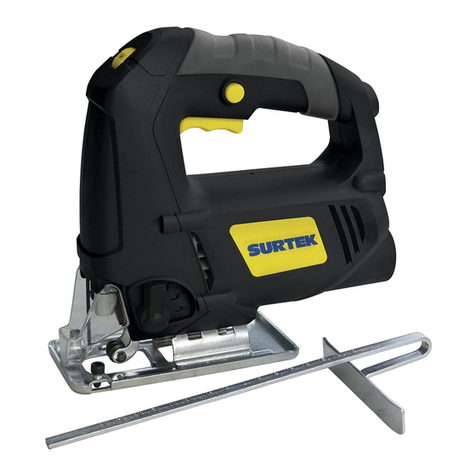
Surtek
Surtek SK503A User manual
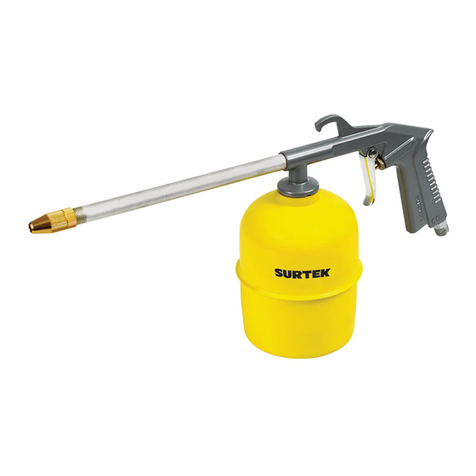
Surtek
Surtek PLM1 Dimensions and installation guide
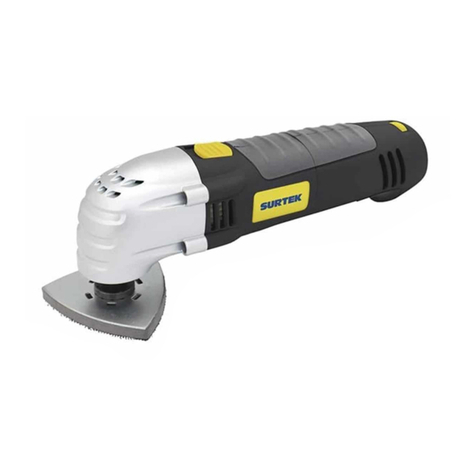
Surtek
Surtek MH600 User manual
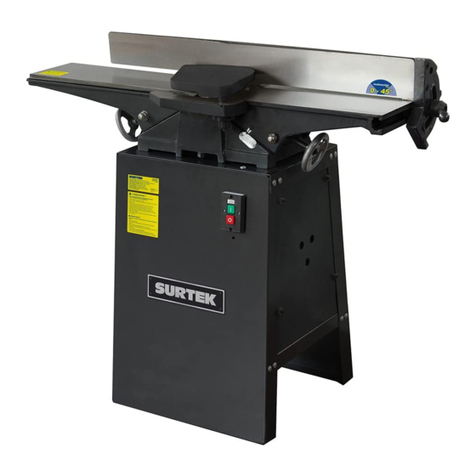
Surtek
Surtek CN606A Dimensions and installation guide
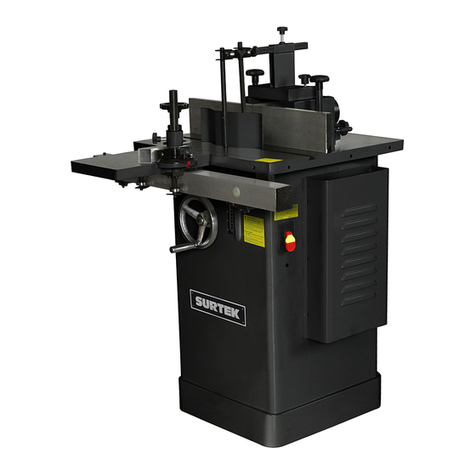
Surtek
Surtek TR702A Dimensions and installation guide
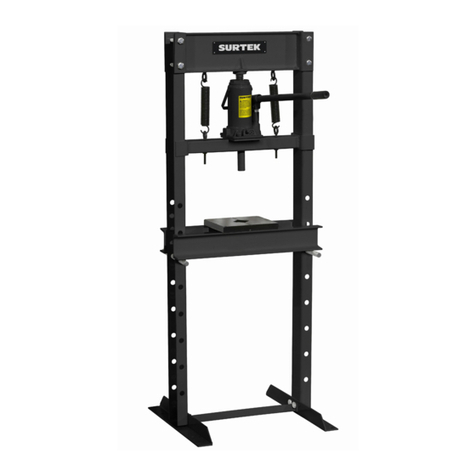
Surtek
Surtek PHI12 Dimensions and installation guide
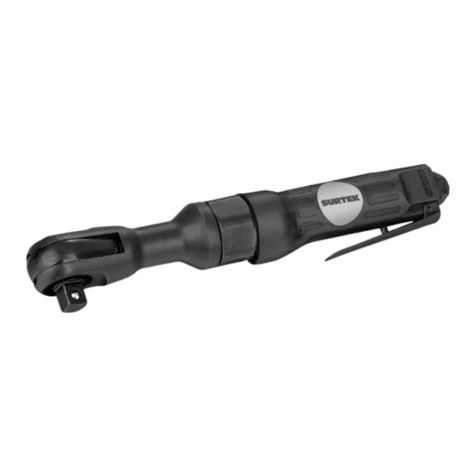
Surtek
Surtek MN638A User manual
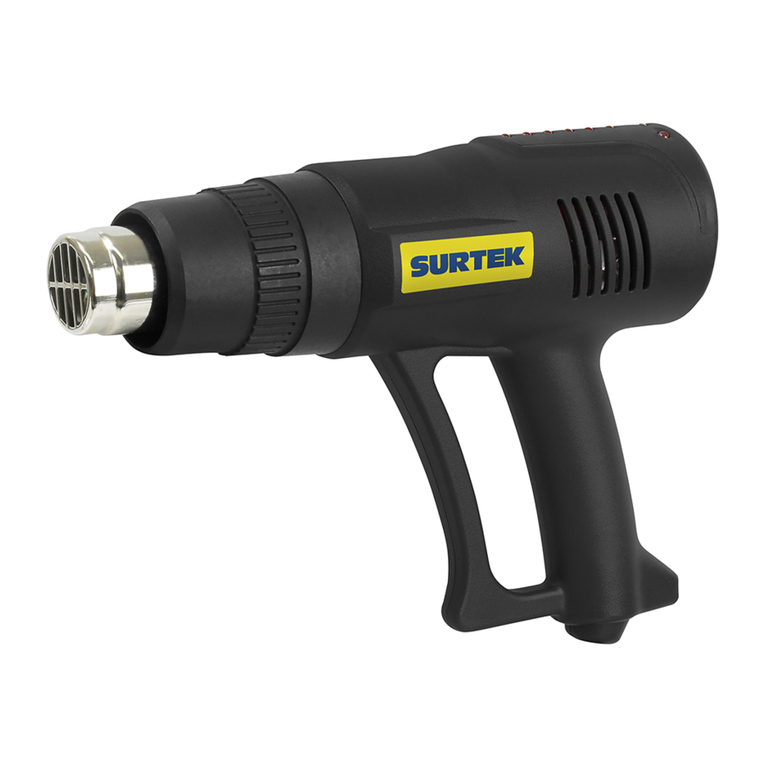
Surtek
Surtek PC600 Dimensions and installation guide
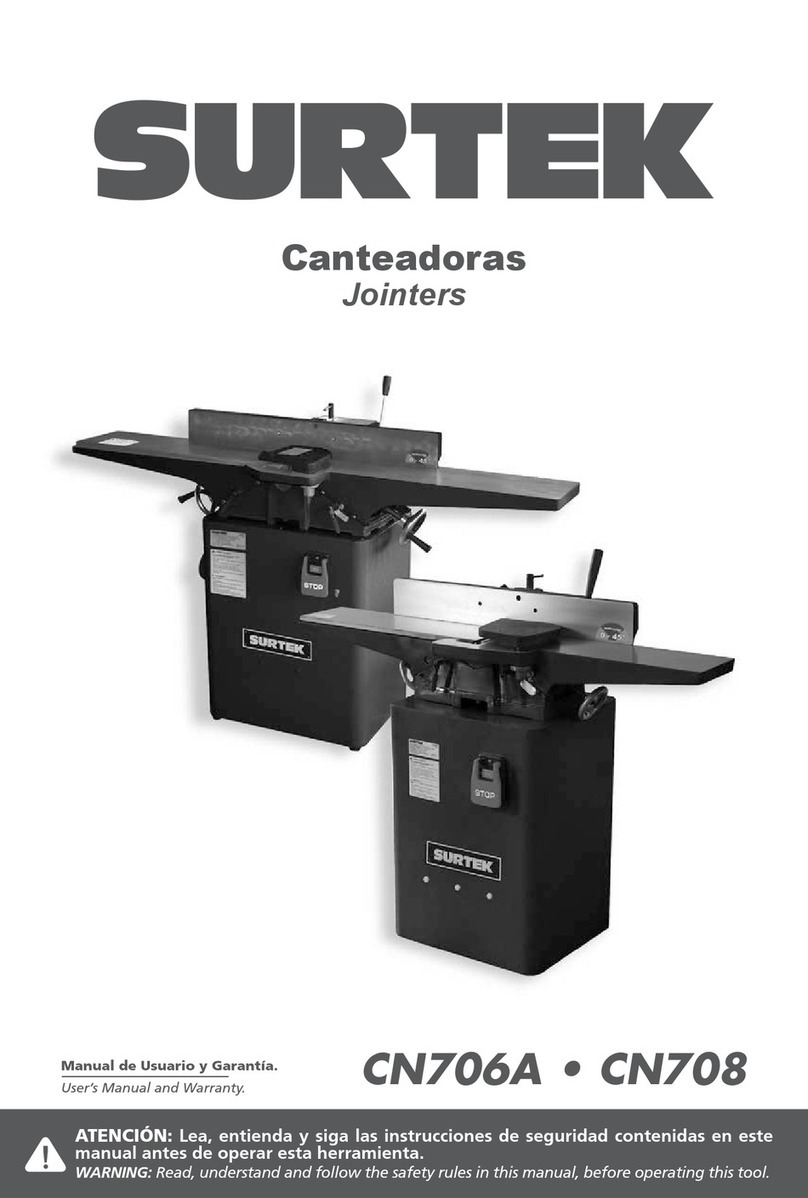
Surtek
Surtek CN708 User manual
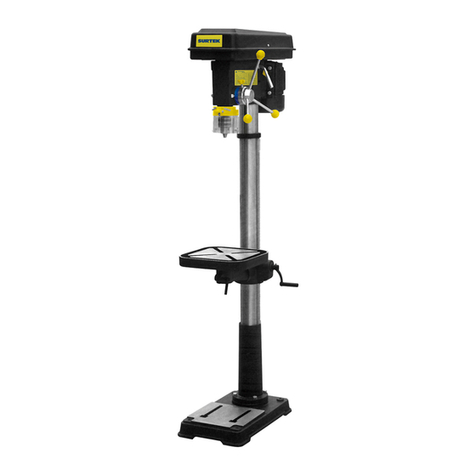
Surtek
Surtek TB572A Dimensions and installation guide
